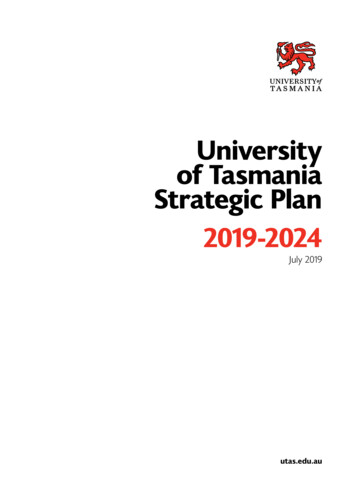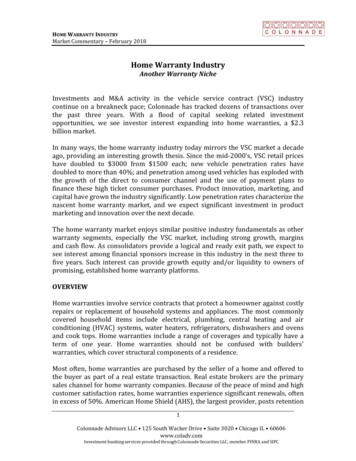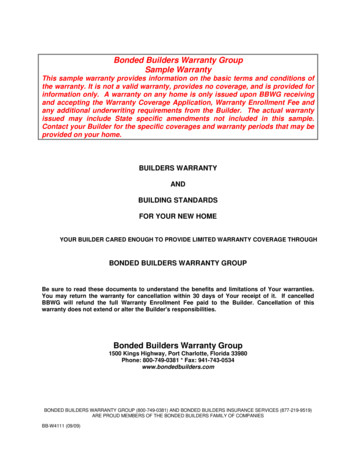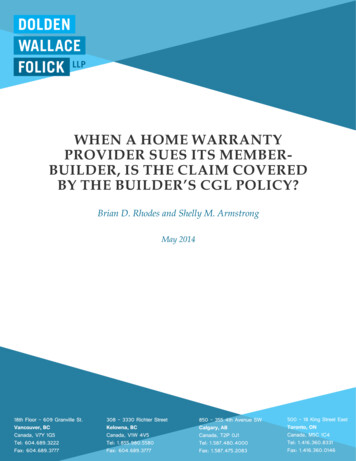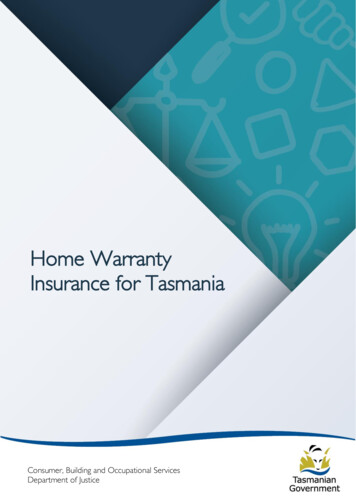
Transcription
Home WarrantyInsurance for TasmaniaConsumer, Building and Occupational ServicesDepartment of Justice
Home Warranty Insurance for Tasmania Government of TasmaniaExcerpts from this publication may be reproduced, with appropriateacknowledgement, as permitted under the Copyright Act 1968For further information, please contact:Department of JusticeGPO Box 825HOBART TAS 7001CBOS.info@justice.tas.gov.auPublished May 2022Home Warranty Insurance – Consultation Paper2
ContentsHome Warranty Insurance for Tasmania . 1How to Have Your Say . 4A Message from the Minister . 5Executive Summary . 6Section 1 - The Tasmanian Building Regulatory Framework . 7Section 2 - Home Warranty Insurance . 10Section 3 - Models. 18Section 4 - Discussion Points . 23Home Warranty Insurance – Consultation Paper3
How to Have Your SayKey DatesPaper Released 6 May 2022Written Submissions Close 6 June 2022How can you Have Your Say?You can make a submission by completing your submission online or by writing to us.If you are making a written submission, please include the name and contact details of the person ororganisation making the submission.OnlineYou can make your submission on the Department of Justice Community Consultation ultation/EmailEmail your submission to HaveYourSay@justice.tas.gov.auPostMail your submission toDepartment of JusticeOffice of the SecretaryGPO Box 825HOBART TAS 7001PublicationSubmissions will be published on the Department of Justice Community Consultation webpage. Yourname or the name of the organisation making the submission will be made public. Please tell us if youwant to keep your submission private.ContactFor more information about this work, or making a submission, contact Consumer, Building andOccupational Services on 1300 654 499 or CBOS.info@justice.tas.gov.au.The Right to Information Act 2009 and confidentialityInformation provided to the Government may be provided to an applicant under the provisions of theRight to Information Act 2009 (RTI). If you have indicated that you wish all or part of your submissionto be treated as confidential, your statement detailing the reasons may be taken into account indetermining whether or not to release the information in the event of an RTI application for assesseddisclosure. You may also be contacted to provide any further comment.Home Warranty Insurance – Consultation Paper4
A Message from the Ministercompliance with recommendations within theBuilding Confidence Report authored byProfessor Peter Shergold and Bronwyn Weir.As Minister for Workplace Safety and ConsumerAffairs, I recognise that buying or building a homeis the biggest investment many families will make,and this is why we are taking action by developinga home warranty insurance scheme, to furtherstrengthen protections for consumers inTasmania. Home warranty insurance coversincomplete or defective building work in theevent that a builder has died, disappeared orbecome insolvent.Given some recent cases of insolvency, this hasbecome a sensible measure to assist consumersin circumstances where this has occurred. Aneffective home warranty insurance scheme willensure that homeowners have access to aspecified level of cover, to protect them fromsignificant loss when making this investment intheir future home.THE HON ELISE ARCHERAttorney-GeneralMinister for Workplace Safety and Consumer AffairsAs Attorney-General and Minister for WorkplaceSafety and Consumer Affairs, I recognise theimportance of a building regulatory frameworkthat is fit for purpose, and provides a range ofcontemporary protections for the benefit ofconsumers undertaking residential building work.The Tasmanian Government continues to be astrong supporter of streamlining industryregulation, as evidenced by our significant reformsthat have strengthened protections forconsumers of residential building work inTasmania.In light of the 2017 building reforms, . This was confirmed by the high degree ofHome Warranty Insurance – Consultation PaperThe reintroduction of home warranty insurancewill add to the range of protections that alreadyexist under the building regulatory frameworkavailable to Tasmanians building homes and thefurther reforms being developed in relation tobuilding defects and disputes.This consultation document is the first step in thedevelopment of a home warranty insurancescheme for Tasmania, and I encourage allTasmanians, including individuals, business andindustry with an interest in this important issue tohave your say on the most appropriate model forour scheme.Your contribution will help us develop a homewarranty scheme for Tasmania that protectsconsumers without imposing unnecessary burdenon industry.5
Executive SummaryThe purpose of this paper is to consult with stakeholders, including both industry and consumers,on the development of a new model for home warranty insurance (HWI) in Tasmania. Thispaper does not provide detailed information relating to the costings of any potential options. Thiswork is to be included in subsequent consultations or Regulatory Impact Statements (RIS).For many Tasmanians, building a home is one of the most substantial financial outlays that theymay ever make. As with any industry, occasionally things may not go to plan, resulting in significantcosts to the consumer, or the prospect of costly and protracted legal disputes.HWI schemes must be designed and implemented to ensure that consumers and homeownersare provided with adequate protection whilst balancing the costs of premiums and administration.While there are a number of existing protections for consumers within the Tasmanian BuildingRegulatory Framework, including provisions in the Residential Building Work Contracts andDispute Resolution Act 2016, the Building Act 2016 and the Occupational Licensing Act 2005, aHWI scheme has been identified as an opportunity to further strengthen the consumerprotections provided when building a home in Tasmania.Structure of this PaperSection 1 of this paper describes the existing consumer protections provided within the buildingregulatory framework.Section 2 explains HWI, including a recent history of HWI in Tasmania and across other statesand territories of Australia, and the key features of HWI models.Section 3 sets out the functions required of any scheme, and the models used in otherjurisdictions.Section 4 explores points to stimulate discussion and feedback in response to this consultationpaper.Home Warranty Insurance – Consultation Paper6
Section 1 The Tasmanian BuildingRegulatory FrameworkSince 2017, Tasmania’s Building Regulatory Framework has included a broad range of buildingindustry-specific features which aim to provide protection to consumers and property owners.At this time, the Tasmanian Government passed two considerable pieces of legislation being theBuilding Act 2016 and the Residential Building Work Contracts and Dispute Resolution Act 2016.These Acts, together with the Occupational Licensing Act 2005, make up Tasmania’s buildingregulatory framework, and provide measures to safeguard consumer interests.Building Act 2016Tasmania’s Building Act 2016 (the Building Act) commenced on 1 January 2017 and provided anew approach to building and construction in Tasmania. This framework significantly reducedunnecessary red tape, supporting industry whilst also providing support and protection forconsumers.The objects of this Act include ensuring: building work, plumbing work and demolition work, including thedesign, and maintenance of domestic, commercial and industrialbuildings, meets, or exceeds, the minimum national constructionstandards; and building work, plumbing work, demolition work and maintenancework do not negatively affect the health and safety of people; andHome Warranty Insurance – Consultation Paper7
owners, building services providers, practitioners and councils comply with therequirements of this Act and the National Construction Code when performing work, orperforming functions and exercising powers, under this Act.Key features of the Building Act include the risk-based approvals of building, plumbing anddemolition work, the ability of the Director of Building Control to make Determinations whichcan react to changing circumstances and technologies in industry, and the ability for buildingsurveyors or the local council to serve Notices and Orders where illegal work has beenperformed, or where a building is not fit for occupation.The Act references the National Construction Code (NCC) for all technical requirements ofbuilding and plumbing work. The NCC sets the minimum standard for all work in Tasmania.Key persons who ensure the compliance and function of the Act include licensed buildingsurveyors, local councils and the Director of Building Control within the Tasmanian Government.All authorised persons play an important role in ensuring the ongoing safety of Tasmania’s builtenvironment throughout the approval and construction stages.Residential Building Work Contracts and Dispute ResolutionAct 2016The Residential Building Work Contracts and Dispute Resolution Act2016 (the Contracts Act) establishes implied statutory warranties for aperiod of six years after completion. The Contracts Act also places limitson deposits paid under building contracts, which are to be in line withbuilding work progress.Mediation and AdjudicationThe Contracts Act also sets out mediation and adjudication processes for resolving disputesbetween building contractors and owners in relation to building work contracts and theperformance of work under those contracts.Tasmania’s Building Regulatory Framework exists toprovide for a safe and effective built environment forall people who own, work, live or conduct business inTasmanian buildings.Occupational Licensing Act 2005In addition to the Building Act 2016, the Occupational Licensing Act 2005 plays an importantrole in Tasmania’s Building Regulatory Framework.Home Warranty Insurance – Consultation Paper8
The Occupational Licensing Act 2005 provides the licensingframework for a number of occupations such as plumbers, gas-fitters,electricians and building services providers. Building services providersis a term that includes a number of building professionals includingbuilding surveyors, building designers, engineers and permit authorities.In addition to providing the mechanisms to licence the above tradesand professions, the Occupational Licensing Act 2005 also includes theability to impose penalties and take other disciplinary action againstlicensees.Vetting of licenseesThe licensing scheme operating under the Occupational Licensing Act ensures that persons areonly granted a licence if they meet minimum qualification requirements. This includes thecompletion of required courses, required years of experience, and meeting fit-and-properconduct standards.The Administrator of Occupational Licensing may also place conditions on a licence due toprotections provided under the Occupational Licensing Act.Tasmania’s licensing scheme exists to ensure that all work carried out in this state is performedby qualified and experienced professionals.Role of home warranty insuranceTasmania’s Building Regulatory Framework relies on provisions from the Building Act, theOccupational Licensing Act and the Contracts Act working together to ensure that all buildingwork is carried out safely, in accordance with national standards and by suitably licensed andcompetent people.However, in the event of business insolvencies, or the death or disappearance of the relevantbuilder, the current framework does not provide an avenue for appropriate remedies foraffected property owners.In other jurisdictions, this gap in consumer protections is addressed by a requirement forhome warranty insurance.Home Warranty Insurance – Consultation Paper9
Section 2 Home Warranty InsuranceHome Warranty Insurance (HWI) schemes cover the homeowner for non-completion anddefects in residential building work. Builders are required to purchase the insurance for eachindividual building project, with the homeowner named as the beneficiary. This differentiates HWIfrom most insurance products where a consumer will take out a specified amount of insuranceto cover their own assets or interests.History in TasmaniaThe now repealed Housing Indemnity Act 1992 (the Housing Indemnity Act) commenced on 1July 1993 and established a compulsory first resort home warranty scheme for Tasmania.Following the collapse of major insurer HIH Insurance, the Housing Indemnity Act was amendedin 2003 to change the scheme to one of last resort. This HWI applied to residential buildingdefects and non-completion, with consumers able to make claims against the policy for a periodof six years after the completion of building work which was consistent with changes occurringacross Australia.The Housing Indemnity Amendment Act 2008 removed the requirement for HWI in Tasmania,moving to a voluntary model from 1 July 2008. This change was due to the increasing costs ofHWI premiums, with premiums in the order of several thousand dollars in some instances.Consumers and building industry stakeholders had been critical of the value of the HWI policies,potentially due to claim rates being very low yet premium costs being relatively high andincreasing.Home Warranty Insurance – Consultation Paper10
The removal of the HWI mandate left consumers wishing to manage such risks to seek aninsurance product from the private market. Due to upheaval in the HWI market, this has notbeen possible in Tasmania for many years.2.1 ObjectivesThe primary objective of a HWI product is to protect consumers from certain adverse eventswhich may occur when undertaking building works in the most efficient way possible.In implementing a HWI mandate there are competing objectives: The level of consumer protection;The cost to consumer, through premiums; andThe sustainability of the scheme over time.All decisions taken to develop and implement HWI must balance these competing objectives.Parameters of the scheme, including the scope of cover, being first or last resort, the applicationof the scheme, claim value limits and statutory warranty timeframes both impact the level ofconsumer protection and the premiums costs paid by the builder and passed on to consumers.Premiums vary across Australia and are calculated taking into consideration the value of the work,the type of building work and the builder’s risk rating as determined by the insurer or risk assessor.Any HWI model for Tasmania would add to the cost of building a home. For example, for a 400,000 building contract, the premium may range between 1,600 and 3,200 or potentiallyhigher. Other jurisdictions have observed the price of premiums relative to the project valuedecrease in recent years.1Essential Services Commission 2019, Victoria’s domestic building insurance scheme: Performance report 2018-19,29 November.1Home Warranty Insurance – Consultation Paper11
2.2 ParametersFirst Resort or Last ResortThere are two models for HWI insurance in Australia: ‘first resort’ and ‘last resort’.A ‘first resort’ insurance product covers all claims for defective and incomplete work irrespectiveof the status of the builder. This model is used by Queensland.A ‘last resort’ insurance product provides cover for defective and incomplete work only in thecircumstance that a builder has died, disappeared or becomes insolvent. This model is used byall other Australian states and territories.‘First resort’ schemes, such as the HWI scheme in Queensland, necessarily result in higherpremiums for property owners. In contrast, the reliance on ‘last resort’ models by mostjurisdictions recognises that the model provides consumer protection at an economical cost.2 Italso recognises that there a more cost-effective mechanisms exist to resolve disputes betweenbuilders and property owners where the builder remains available to address identifiedincomplete or defective work.Proposed way forward: Tasmania’s HWI will be a ‘last resort’ model.Application of HWIUnder a HWI mandate, a licensed builder must take out a policy with the homeowner asbeneficiary before commencing any residential building work over a set value. This value can bedescribed as an application trigger.In jurisdictions with ‘last resort’ HWI mandates, HWI requirements are required for work from 12,000 to 20,000 .HWI application triggers by ,000.0012,000.003,300.00ACTNSWNTQldSAVicWAIn Tasmania, the current trigger for consumer protections for building work is defined by theContracts Act. The Contracts Act applies to residential building work performed, or to beperformed, for a contract price that is 20,000 or greater. This application value captures allmajor renovations and all new residential building construction including additions, substantialalterations and new dwellings.2Commonwealth of Australia, Senate Standing Committee on Economics, Final Report: Australia’s mandatory LastResort Home Warranty Insurance Scheme, November 2008.Home Warranty Insurance – Consultation Paper12
Impacts – Application of HWIThe application trigger for HWI in Tasmania may impact a number of elements of the scheme.The lower the trigger is set the larger the premium pool available to provide for eligible claims.Similarly, it is observed that lower value projects are likely to have lower risk of claims. Together,these may have a positive impact on premiums.However, if the trigger is set too low, it is likely to include property owners and projects wherethe potential for consumer harms are low and self-insurance may be a more appropriate option.The existing approach in the Contracts Act, which applies to all residential building work contractsover 20,000, offers a way forward which balances these competing objectives.Proposed way forward: HWI be mandated for residential building work contracts valued at 20,000 or greater.Claim value limitsAll HWI schemes place limits on the value of claims which can be made. Some schemes have afixed maximum claim limit, while other schemes have different limits dependant on the nature ofthe claim.These claim value limits typically align with existing consumer protections within the respectivejurisdictional building regulatory framework. This places a cap on the exposure of the HWIscheme, and provides cover only for the risks the property owner is unable to manage forthemselves.JurisdictionACTNSWClaim Limit 85,000 340,000NT 200,000Qld 200,000SAVic 150,000 300,000WA 100,000Carve-outs/AdditionsCapped at 20% of contract price for noncompletionCapped at 20% of contract price for noncompletionOptional additional cover available up to 300,000 total per dwellingCapped at 100,000 pre-completion for multiresidential buildings (i.e. duplex)Capped at 20% of contract price for noncompletionNon-completion and/or defective workA claim value limit for non-completion reflects the expectation that home owners will have madeprogress payments to the builder according to normal practice in the building industry. If thebuilder does not complete the work, it is assumed that the loss experienced by the consumerwill be capped by virtue of these protections.Home Warranty Insurance – Consultation Paper13
In Tasmania, progress payments are also a statutory requirement set by the Contracts Act. Thisis provided to limit the likelihood of significant financial loss for building work that is notcompleted.In several jurisdictions claim limits for non-completion of building work provide cover for loss upto 20 per cent of the contract price, to a maximum monetary limit.Deposits PaidIt is sometimes the case that a homeowner pays a deposit under a contract for building workand the builder dies, disappears or becomes insolvent prior to commencing the work. In thosecircumstances, HWI schemes are most commonly designed to cover the loss incurred by thehomeowner capped at the maximum deposit amount legally payable under the relevant buildingcontracts legislation. In Tasmania, that limit is 5 per cent of the total contract value.Impacts – Claim Value LimitsClaim value limits have a substantial impact on the cost of premiums. This is true for allinsurance products, the higher the value of cover, the higher the cost to purchase the policy.By aligning the payment limits with the existing consumer protections (5 per cent for deposits,20 per cent for incomplete or defective work), the HWI product provides reasonable cover forrisks that a consumer is unable to manage for themselves.In addition, a claim value cap will assist in managing risks to the viability of the scheme overtime. Across jurisdictions there is a claim value limit of between 85,000 and 340,000.A claim value limit of 200,000 in Tasmania is expected to balance the costs of premiums whilestill providing adequate cover to the majority of affected homeowners.Proposed way forward: Tasmania’s HWI will have a claim limit of 5 per cent for deposits and20 per cent for incomplete or defective work, up to a maximum of 200,000.Claims & warranty periodsHome warranty insurance schemes are time-limited, applying for a set period following thecarrying out of the building work. Most jurisdictions have put in place warranty periods of sixyears for non-completion and structural defects. This aligns with the existing statutory warrantyperiod already provided in Tasmania under the Contracts Act. Any model of HWI in Tasmaniais likely to align with this existing statutory warranty period in the Contracts Act and the nationalaverage claims period.Some defects are not apparent during construction or immediately after the completion of thebuilding work. This can occur for a number of reasons, and is not always a failing of the builder,building surveyor or the designer. A six-year warranty period is considered sufficient time fordefects to be identified following construction.Impacts – Claims & warranty periodsThe duration of cover under a HWI scheme will impact upon the cost of premiums. The longerthe warranty cover, the greater protection for the consumer. However, this also results in higherthe cost of premiums. A warranty period of up to six years after completion is standard in alljurisdictions other than South Australia (which is five years) and provides sufficient time fordefects to be identified and rectified.Home Warranty Insurance – Consultation Paper14
Proposed way forward: It is proposed that Tasmania’s HWI have a claim and warrantyperiod of six years.2.3 Other relevant mattersExemptionsThe mandatory nature of HWI is an important feature of Australian schemes. It reduces moralhazard and ensures that there is a broad premium pool to meet expected future claims.Further, because building a home is one of the most significant financial decisions many propertyowners will make, the consequences of a builder’s death, disappearance of insolvency can becatastrophic for private finances. Given these potential consequences, mandating HWI isappropriate to minimise consumer harm.It is for these reasons that exemptions are typically limited in nature and relate to building workwhere the potential for harm is low or existing risk management arrangements exist. An exampleof this is the development of social and public housing funded by the Tasmanian Governmentwhere commensurate cover is provided through existing schemes and arrangements.Proposed way forward: Residential building work for state funded social and public housingprojects will be exempt from HWI.ExclusionsHWI insurance schemes in all Australian states are limited to residential building work. They donot cover commercial, public or other buildings.In most jurisdictions, there are also limitations on multistorey residential buildings, such as thosewhich exceed three storeys. This reflects the different risk profile for such buildings and thearrangements put in place to manage such risks.It is for a similar reason that such residential building work is excluded from protection under theContracts Act.Some jurisdictions also limit the cover for multi-dwelling developments. For example, Victoriadoes not provide non-completion cover for developments including 3 or more dwellings.Proposed way forward: Residential building work that exceeds three storeys be excludedfrom requiring HWI.Transitional ArrangementsThe commencement of a HWI scheme in Tasmania will impact on currently licensed andpracticing builders and building companies. Some building companies may need to alter theircurrent business practices in order to secure ongoing certificates of eligibility.Home Warranty Insurance – Consultation Paper15
From the commencement of a HWI scheme, builders will be required to obtain certificates ofeligibility prior to contracting for residential building work. There may be a requirement fortransitional arrangements to facilitate such a large number of builders and building companiesrequiring immediate cover.Options for transitional arrangements may include a staggered implementation based onresidential building work contract values, or for builders contracting for a certain maximum valueof contract work. Alternatively, providing a longer lead time prior to implementation of a schememay allow all builders to secure eligibility prior to the commencement date, and provide theinsurer with sufficient time to assess and determine applications for eligibility.Proposed way forward: Transitional arrangements be put in place to ensure continuity forindustry and consumers, subject to appropriate risk management principles.Grandfathering arrangementsWhen implemented, it will be a requirement for a builder to purchase HWI insurance onbehalf of the property owner prior to commencing building works.This means that for property owners with current residential building work projects underway,they remain exposed to the risks associated with the death, disappearance or insolvency oftheir builder.The Tasmanian Government has recently stepped in to address this gap by providing financialassistance to property owners affected by construction company collapse.This is an interim solution which has been put in place while the details of the HWI aredeveloped. To manage the risks for this cohort of property owners, it is proposed that they begiven the opportunity to voluntarily purchase equivalent cover to that proposed by the HWIscheme. The premiums would be set according to risk principles, with any additional costs tothe scheme met by the Tasmanian Government.Proposed way forward: Property owners with building works currently underway be given anopportunity to purchase an equivalent level of cover.Transfer of insurance on saleIn Tasmania, the Contracts Act provides property owners an implied statutory warranty forbuilding works for a period of six years. It is for this reason that it is proposed that the claimperiod for HWI be for a similar period.This implied statutory warranty is transferrable on sale and may be exercised by subsequentowners of a property. It is proposed that the insurance interest also be transferrable on sale, fora similar period.Proposed way forward: The property owner’s interest in a HWI insurance policy will transferon sale, within the claim period.Home Warranty Insurance – Consultation Paper16
Owner buildersOwner builders are individuals who build their own homes. To be an owner builder, anindividual requires a licence but is limited to building a residence for their own use on propertythey own. An owner builder is required to undertake certain training prior to gaining a licencebut is not required to have the skills and experience of a licensed builder.It is a feature of HWI schemes in other jurisdictions that owner builders are also required toobtain insurance. The primary purpose of this insurance is to protect subsequent propertyowners in the event of defective work.Owner builder policies are generally higher risk, due to the limited experience of the ownerbuilder, and therefore incur a higher premium cost. Additional costs may also be applied if theinsurer requires more detailed progress inspections to be carried out by a suitably licensed andcompetent person.Proposed way forward: Owner builders will be required to purchase HWI cover to managethe risks to subsequent owners.Home Warranty Insurance – Consultation Paper17
Section 3 ModelsIntroducing an insurance mandateInsurance mandates are a common policy tool used by government to manage risks to consumersand the community. Examples of this are widespread and include the requirement for licensedprofessionals to hold professional indemnity insurance or the requirement for employers to holda workers compensation policy to cover their employees.In many cases, such insurance products are readily available in the private market with limitedgovernment intervention or oversight.This is not the case with HWI. HWI schemes differ to that of typical market insurance products.In all cases, HWI is underwritten to a certain degree by the state or territory governmentmandating the scheme. This government involvement came about as a result of departure of allmarket
Home Warranty Insurance - Consultation Paper 10 Section 2 - Home Warranty Insurance Home Warranty Insurance (HWI) schemes cover the homeowner for non-completion and defects in residential building work. Builders are required to purchase the insurance for each individual building project, with the homeowner named as the beneficiary.
